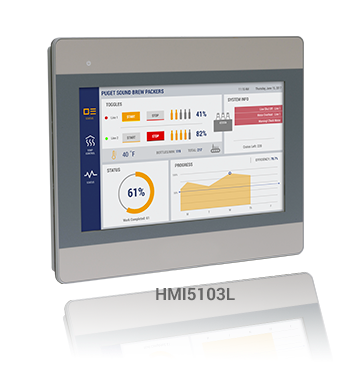WiFi is indispensable in today’s industrial controls marketplace — so control devices have evolved to include WiFi connectivity. One catch: Industrial control networks must function in realtime and be available, responsive, and secure — design objectives that often conflict with pressures to reduce costs while boosting connectivity and remote access. As a solution, Maple Systems HMI5103L HMIs now offer secure access points to an existing WiFi networks — to provide unified, reliable, and easy production management.

Some benefits of implementing a WiFi network in smart factories and designs with WiFi-connected HMI5103Ls include:
Ease of expandability. Initial setup via the WiFi network is easy — as is serving a suddenly-increased number of clients with existing equipment. In a wired network, additional clients would need additional wiring.
Reduced costs by creating a wireless network on the factory floor. WiFi can solve applications where wiring is impractical or too expensive. There’s no need to run expensive Ethernet or Serial cables throughout plant. Add a WiFi router to network, and the design is ready to go.
Flexible communications and troubleshooting. Use a WiFi enabled laptop to troubleshoot machines without having to find a network access point … or carry around extra cables.
Supporting Maple Systems HMI5103L WiFi features include IEEE 802.11 b/g/n and WPA-PSK/WPA2-PSK encryption; ability to turn WiFi on or off from within its program; DHCP or Static IP options and the project uploads and downloads over WiFi; and EasyAccess 2.0 for secure (VPN) remote access from outside the local network.
With the HMI5103L, one can conveniently divide industrial control and remote access/data collection functionality between two distinctly separate networks. Connect via Ethernet or serial to PLC’s local control network, then use the HMI5103L’s built-in WiFi connectivity to send pertinent information to users via the plant or corporate network. The HMI becomes a gateway into control network. PLC and other machine hardware on the control network can’t be directly accessed, which greatly improves security and preserves bandwidth for time critical control tasks. Additional benefits of the WiFi HMI5103L include:
- Built-in EasyAccess 2.0 is included in the cost of the HMI5103L, allowing secure remote access to the HMI for remote viewing and troubleshooting. Learn more about EasyAccess 2.0 by clicking here.
- Better mobile applications. Case in point: Warehouses with automated ground vehicles (AGVs) that can’t be tethered with wires can now connect to WiFi networks via the HMI5103L for control instructions.
- Expandability. Aside from the initial ease of setup for a WiFi network, wireless networks can serve a suddenly-increased number of clients with the existing equipment. In a wired network, additional clients would need additional wiring.

Maple Systems HMI5103L HMIs have WiFi access to support maintenance of segregated networks and satisfy security-conscious — and the HMI5103L is a cost-effective HMI as well.
Some final notes on WiFi and industrial-network security
Many PLCs leverage Ethernet communications to transmit data to monitoring devices such as HMIs. Plant corporate networks may also run via Ethernet and WiFi networking … but how does one get data from the PLC to the corporate network without the bandwidth or security sacrifices of placing the PLC on the same network?
Here’s where Maple Systems HMI5103L HMIs with WiFi can help to divide industrial control and remote access between distinct networks. The HMI5103L can connect via Ethernet or serial to PLC on a local control network, and use its built-in WiFi connectivity to send pertinent information to users via the plant network. The PLC can transmit everything to the HMI without having to deal with slowdowns or network traffic, and the HMI can maintain a connection to the plant network for VNC monitoring, sending status reports, data log files, and e-mail alarms.
In the event of a catastrophic issue that causes an operation’s main network to go down, the HMI5103L maintains its PLC connection … so the controlled machine continues running.
Filed Under: Motion Control Tips





Tell Us What You Think!